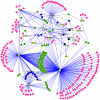Synergy analysis reveals association between insulin signaling and desmoplakin expression in palmitate treated HepG2 cells
- PMID: 22132232
- PMCID: PMC3223234
- DOI: 10.1371/journal.pone.0028138
Synergy analysis reveals association between insulin signaling and desmoplakin expression in palmitate treated HepG2 cells
Abstract
The regulation of complex cellular activities in palmitate treated HepG2 cells, and the ensuing cytotoxic phenotype, involves cooperative interactions between genes. While previous approaches have largely focused on identifying individual target genes, elucidating interacting genes has thus far remained elusive. We applied the concept of information synergy to reconstruct a "gene-cooperativity" network for palmititate-induced cytotoxicity in liver cells. Our approach integrated gene expression data with metabolic profiles to select a subset of genes for network reconstruction. Subsequent analysis of the network revealed insulin signaling as the most significantly enriched pathway, and desmoplakin (DSP) as its top neighbor. We determined that palmitate significantly reduces DSP expression, and treatment with insulin restores the lost expression of DSP. Insulin resistance is a common pathological feature of fatty liver and related ailments, whereas loss of DSP has been noted in liver carcinoma. Reduced DSP expression can lead to loss of cell-cell adhesion via desmosomes, and disrupt the keratin intermediate filament network. Our findings suggest that DSP expression may be perturbed by palmitate and, along with insulin resistance, may play a role in palmitate induced cytotoxicity, and serve as potential targets for further studies on non-alcoholic fatty liver disease (NAFLD).
Conflict of interest statement
Figures





Similar articles
-
Palmitate-Induced IRE1-XBP1-ZEB Signaling Represses Desmoplakin Expression and Promotes Cancer Cell Migration.Mol Cancer Res. 2021 Feb;19(2):240-248. doi: 10.1158/1541-7786.MCR-19-0480. Epub 2020 Oct 26. Mol Cancer Res. 2021. PMID: 33106375 Free PMC article.
-
Protective effect of metformin against palmitate-induced hepatic cell death.Biochim Biophys Acta Mol Basis Dis. 2020 Mar 1;1866(3):165621. doi: 10.1016/j.bbadis.2019.165621. Epub 2019 Nov 29. Biochim Biophys Acta Mol Basis Dis. 2020. PMID: 31786336
-
MiR-1271 upregulated by saturated fatty acid palmitate provokes impaired insulin signaling by repressing INSR and IRS-1 expression in HepG2 cells.Biochem Biophys Res Commun. 2016 Sep 30;478(4):1786-91. doi: 10.1016/j.bbrc.2016.09.029. Epub 2016 Sep 7. Biochem Biophys Res Commun. 2016. PMID: 27613089
-
Reconstruct modular phenotype-specific gene networks by knowledge-driven matrix factorization.Bioinformatics. 2009 Sep 1;25(17):2236-43. doi: 10.1093/bioinformatics/btp376. Epub 2009 Jun 19. Bioinformatics. 2009. PMID: 19542155 Free PMC article.
-
Lethal acantholytic epidermolysis bullosa.Dermatol Clin. 2010 Jan;28(1):131-5. doi: 10.1016/j.det.2009.10.015. Dermatol Clin. 2010. PMID: 19945626 Review.
Cited by
-
Fatty Acids and a High-Fat Diet Induce Epithelial-Mesenchymal Transition by Activating TGFβ and β-Catenin in Liver Cells.Int J Mol Sci. 2021 Jan 28;22(3):1272. doi: 10.3390/ijms22031272. Int J Mol Sci. 2021. PMID: 33525359 Free PMC article.
-
Elevated free fatty acid uptake via CD36 promotes epithelial-mesenchymal transition in hepatocellular carcinoma.Sci Rep. 2015 Oct 1;5:14752. doi: 10.1038/srep14752. Sci Rep. 2015. PMID: 26424075 Free PMC article.
-
Characterization of transcription factor response kinetics in parallel.BMC Biotechnol. 2016 Aug 24;16(1):62. doi: 10.1186/s12896-016-0293-6. BMC Biotechnol. 2016. PMID: 27557669 Free PMC article.
-
Palmitate-Induced IRE1-XBP1-ZEB Signaling Represses Desmoplakin Expression and Promotes Cancer Cell Migration.Mol Cancer Res. 2021 Feb;19(2):240-248. doi: 10.1158/1541-7786.MCR-19-0480. Epub 2020 Oct 26. Mol Cancer Res. 2021. PMID: 33106375 Free PMC article.
-
Nutrient-induced intestinal adaption and its effect in obesity.Physiol Behav. 2014 Sep;136:74-8. doi: 10.1016/j.physbeh.2014.03.026. Epub 2014 Apr 1. Physiol Behav. 2014. PMID: 24704111 Free PMC article. Review.
References
-
- Angulo P. Obesity and nonalcoholic fatty liver disease. Nutr Rev. 2007;65:S57–63. - PubMed
-
- Musso G, Gambino R, De Michieli F, Cassader M, Rizzetto M, et al. Dietary habits and their relations to insulin resistance and postprandial lipemia in nonalcoholic steatohepatitis. Hepatology. 2003;37:909–916. - PubMed
-
- Zelber-Sagi S, Nitzan-Kaluski D, Goldsmith R, Webb M, Blendis L, et al. Long term nutritional intake and the risk for non-alcoholic fatty liver disease (NAFLD): a population based study. J Hepatol. 2007;47:711–717. - PubMed
-
- Musso G, Gambino R, Cassader M. Recent insights into hepatic lipid metabolism in non-alcoholic fatty liver disease (NAFLD). Prog Lipid Res. 2009;48:1–26. - PubMed
Publication types
MeSH terms
Substances
Grants and funding
LinkOut - more resources
Full Text Sources
Medical
Molecular Biology Databases
Miscellaneous

